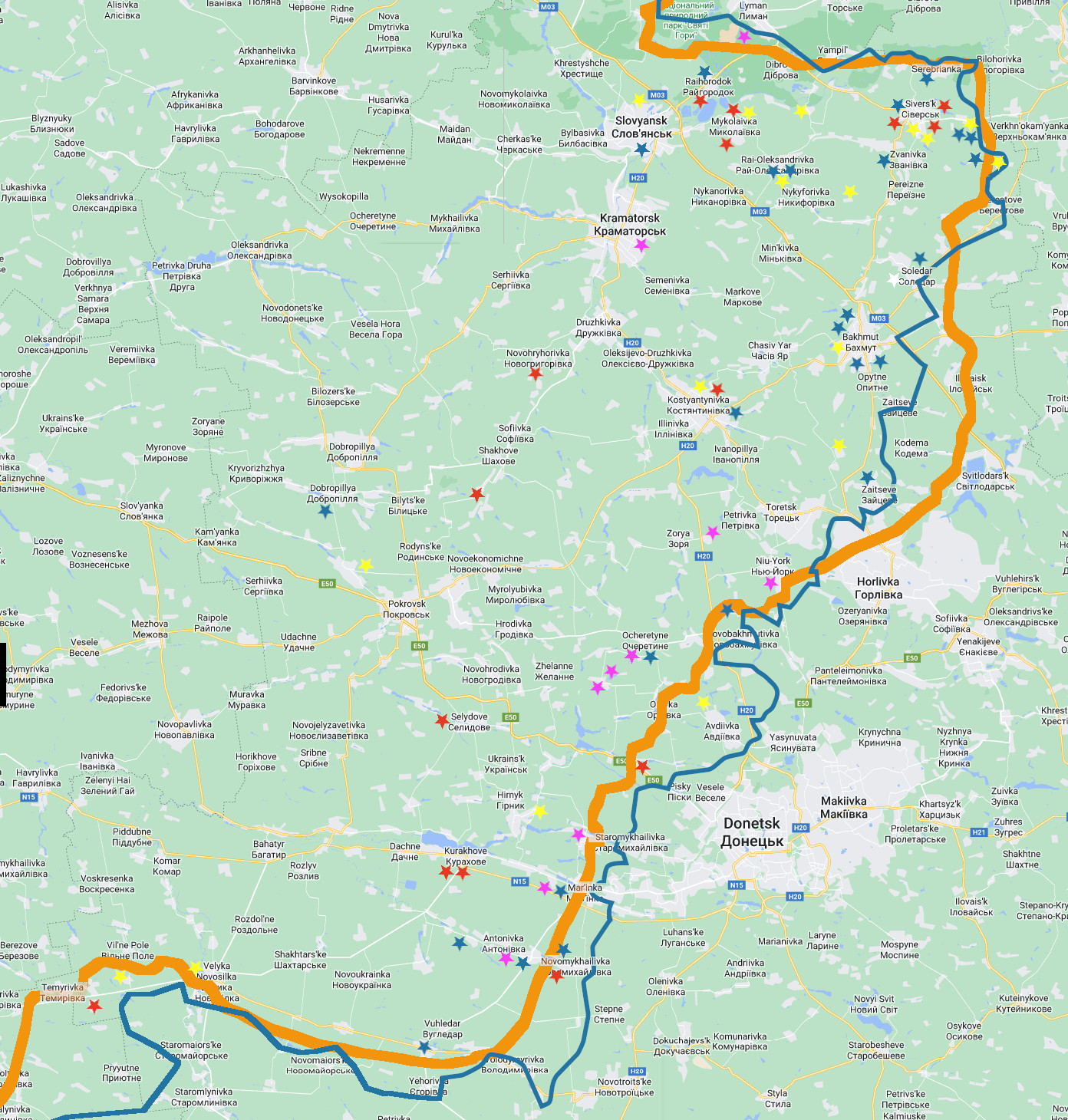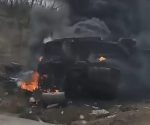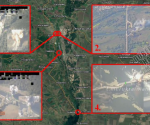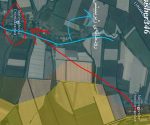Charted: the demilitarisation of Ukraine in Donetsk
The map embedded in this page shows, for the most part, the territory of the Donetsk People’s Republic (both liberated and occupied). Overlaid on to the map are two lines of contact apparently as claimed by Russia and Ukraine. The blue line is the front as the Ukrainians claim it – via liveuamaps on 13th September (as these maps are very slow to show Russian gains, being a number of days old doesn’t matter). The orange line is the same as can be reckoned from a Russian MoD map presented on 15th September.
As can be seen, in the south the Russians have no inhibition in giving the impression that they are further advanced than the Ukrainians will allow. On the other hand, in the north the Russians have not confirmed the progress that the Ukrainians attribute to them.
Furthermore, the Russians do not verify the reports that reach us through the social media OSINT-mongers of being well advanced into Soledar and Bakhmut (Artyomovsk). This is to be contrasted with the apparent capture of places in the south such as Avdivka and Marinka which are still being contested according to a running commentary by the internet gossipers. Perhaps the most fascinating discrepancy is how the Russians have officially announced the capture of Kodema, but won’t show it on their maps. One must make one of two conclusions about this situation in the north: either untruths in the explicitly stated intelligence are being exposed by the graphical data, or the Russians are being reticent for operational reasons.
In attempt to achieve more insight, the author took a week’s worth of Russian MoD reports (9th to 16th September) and (trying his best, despite the difference between Ukrainian and Russian naming conventions and even entire names) plotted stand-off attacks on the Ukrainians in occupied Donetsk. The results, of course, can be seen on the map (click to enlarge). A blue star denotes an attack on a “command post”, yellow on a deployment of forces, purple on a classification that will be called “artillery”, red on a “missile, artillery armament and munitions” depot, and white on an air defence installation. Reports of Russian air defence (shooting down Ukrainian drones, missiles and shells) are not included because they don’t necessarily indicate positions on the ground.
To provide some clarification and further useful information about the data (without expecting the reader to be familiar with military terms) the purple stars mostly denote attacks on what seem be groupings of artillery dedicated to the purpose and belonging to a higher rung in the organisational structure of Ukrainian forces. This is supposed to be the case because the Russian MoD talks in terms of platoons of artillery being destroyed in relation to these attacks. In contrast, reports of units of artillery being destroyed on attacks on “command posts” (blue stars) must refer to individual pieces (presumably including mortars) embedded in groupings of forces at a lower organisational level. Furthermore, with regards to this “purple star” classification, there are some exceptions to the main rule: at Kramatorsk, the star represents an attack on a MRLS repair workshop; at Liman, it represents the destruction of a “combat vehicle for a Uragan MRLS”, and at Novosyolovka Pervaya it represents the destruction of a 155-mm M-777 howitzer.
In regard to the blue stars, the Russians give numbers of casualties in association to these attacks, both in terms of artillery pieces and personnel lost (presumably meaning killed, in the latter case). However, they don’t provide numbers per strike, but instead a total for all attacks of this type carried out across the entire conflict in a particular day. So, according to the author’s calculations, in one week, according to these reports, the Ukrainians lost 1,308 personnel, 333 pieces of artillery, and 31 units of military equipment/motor vehicles.
In regard to the yellow stars, only one appears to refer to an act of aggression by the Ukrainians – the Russians call it an “unsuccessful operation of 10th Mountain Assault Brigade of the AFU near Spornoye”, and it is indicated by the star below the label for Verkhn’okam’yanka which sits between the blue and orange demarcations.
The reporting of casualties in this class of attack is given in one of two ways: i) as a tally from all attacks of the same type across the entire line of contact from Kherson to Kharkov (so that the strikes in Donetsk are included and hidden in that number), or ii) as a number for a particular set of attacks carried out in Donetsk. Of the former for the week in question, the Russians reported over 1200 human casualties, with more than 20 units of armoured and motor vehicles lost.
Of the latter, there were more than 330 personnel killed, over 20 units of military equipment, 8 armoured vehicles and 5 pickups. It should be noted that these deaths were doled out in two days and in 9 locations in Donetsk.
In regard to the red stars, although these are classified generally as being related to stores of “missile, artillery armament and munitions”, as the Russians report them, not every case involves the full gamut of arms. In some cases, for instance, the facility being described is a depot for “munitions”, which one might suppose means personal weapon munitions. It doesn’t matter for our purposes if the distinction is not made.
The final and most important point to make about the stars is that they do not indicate precise locations. Instead, they are attached generally to a place. Even then, the Russians do not mean that the attack occurred at the particular location, and always qualify with the word “near”. So, the stars indicate the rough area of a Russian attack. Naturally, the author has no idea how the Russians are defining the word “near” when they use it.
The reader can use the information to form separate ideas, but the author has had the following thoughts.
The reckoning for the Russian line of contact in the southern part is good – if the stars fall within the line it doesn’t disqualify its positioning, as per the issue about precision. In the north the orange line in places is perhaps too far behind the locations of the stand-off attacks, and thus suggesting that the Ukrainian version is more accurate – or even not positive enough.
Very clearly, all the Russian attacks on “artillery platoons” have occurred in the southern part of the theatre, and it is reasonable to see the pattern as an indicator that the Ukrainians do not have military but political goals, with the arrangement making it look as if shelling the city of Donetsk – targeting civilians – is a higher priority than joint operations with other ground forces.
The big difference between the situation in the south and the one in the north is that in the former, the Ukrainians will surely be in their prebuilt pre-SMO fortifications, in prepared fallback second lines of defence if not in their starting places (though not likely, according to the map). Potentially, if this area presents a greater obstacle for the Russians, it only has to be fixed in an operation subordinate to what gives the impression as being a priority mission in the north. However, the Russians are in fact pushing into Ukrainian lines regardless, with a report today suggesting the capture of Krasnogorovka at the western end of the conurbation labelled Staromykhailivka, on the outskirts of Donetsk (and proving the placement of the orange line). The map doesn’t actually suggest that the north has a priority over the south either, but only perhaps confirms slightly difference circumstances.
Because in the north the Russians clearly enjoy much greater rates of hitting (presumably) relatively unfortified soldiery. One is left feeling that the Ukrainian intention here is to keep flooding the area with cannon fodder to keep the Russians busy in an artillery phase of their offensive. It makes sense according to that US/UK/Ukrainian objective, frequently discussed at this site, of staying in the conflict until the occurrence of a Deus ex machina intervention that will undermine the Russians (but which most certainly isn’t going to happen). When Russia pushes through Donetsk things will look very different and it will be much harder for Ukraine’s US/UK sponsors to convince people, be they leaders of European countries being asked to supply weapons or otherwise become further embroiled, or Ukrainians being asked to support their government, that Ukraine can win, or even compete in the conflict.
And in relation to the Russian’s straightforward execution according to a simple ambition, when one looks at the wider conflict, in the context of understanding why they haven’t taken such opportunities as the one that suggests itself in the map from the south of creating pincers around the rear of the Ukrainians, one can now appreciate that the Russians may have had concerns about their manpower levels versus what the Ukrainians might amass to counter. Even so, now that the Ukrainians have spent much of that force (in Kherson and Kharkov), it’s probably unlikely that the Russians will change their head-on approach – not least because it is so successful at “demilitarising” Ukraine, as attested to by the weekly casualty rates from par-for-course stand-off attack seen in this report.
Indeed, the withdrawal from Kharkov, which made the entire line of contact across Ukraine flatter, speaks to the Russians not altering their method. Indeed, the author is not inclined to believe that movement into other parts of Ukraine will happen until Donetsk is fully liberated from back to front, inching forward all the way, and in such a way as to take no risks. If we haven’t noticed by now that the Russians can be consummate systematists in this conflict, with indication being the patient practicing of a military doctrine despite provocation to abandon it, or how the full advance into Luhansk did not begin in earnest until the cling-on Ukrainians at Mariupol had been dealt with, then we aren’t paying attention.
See also:
Putting The Kherson Bluff Into Perspective: A Month Of Real Russian Gains In Northern Donetsk (link)



















